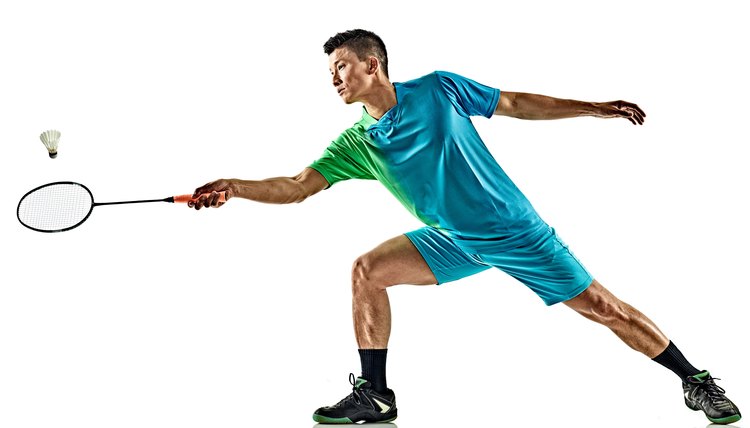How to Improve Stamina in Badminton

The fastest racket sport in the world, badminton demands high levels of strength, power and endurance. With competitive matches lasting at least 45 minutes, players need to be able to perform aerobically for long periods of time. A mixture of long, slower paced cardio, intense cardio intervals and sport-specific drills will help you build the stamina necessary to smash your opponents.
Aerobic Training
Any cardiovascular exercise that's progressive -- either in duration or intensity -- will help you build stamina. In doing so, you train your body to take in more oxygen and to use that oxygen more efficiently during longer and more intense periods of exercise.
According to the Badminton Association of England, a varied approach to aerobic training is the key to successfully building endurance. The Association recommends four distinct types of training: duration, long interval, medium interval and short interval.
Duration Training
Duration training trains your body to operate at a steady, low to moderate intensity for an extended period of time. Longer, slower paced cardio sessions make the heart more efficient and strengthen the aerobic energy system that provides energy slowly but efficiently. It's the most important type of training if you want to produce energy for extended periods of time. Duration training is also a necessary part of recovery to balance the more intense training you do.
Duration training is any activity done at a slow to moderate pace for 30 minutes or longer. You can bike, swim, run, row or do any other activity that keeps your heart rate steady for the duration.
Read more: Fundamental Skills & Rules in Badminton
Interval Training
Interval training involves short bursts of intense effort followed by periods of recovery and is similar to actual gameplay. Because rally lengths vary, you should train long, medium and short intervals. Intervals are often done running on a track or treadmill, but they can also be done on a bike.
Long intervals: After a brief warm-up, run at the fastest pace you can maintain for 4 minutes, then jog for three minutes. Repeat the interval four more times.
Medium intervals: After warming up, sprint for 40 seconds, then walk for 2 minutes. Repeat four more times, then rest for 2 minutes. Repeat the set three more times, resting for 2 minutes between sets.
Short intervals: After warming up, sprint for 10 seconds, then walk for 30 seconds. Repeat three more times, then rest for 2 minutes. Repeat the set four more times, resting 2 minutes after each set.
Drills
Drills help you build stamina in a sport-specific way that closely mimics gameplay.
Wall rally drill: Select a wall at least 20 feet in height and repeatedly hit your shuttle against the wall as it ricochets back, practicing forehand, backhand, straight and diagonal hits with your racquet. Continue for sessions of 10 minutes with a 2 minute rest between each set.
Multiple Shuttles: Have a partner hit multiple shuttles into different areas of your backcourt. Alternate forehand, backhand and around-the-head shots on the incoming shuttles, and return to your base position after each shot. For an increased stamina workout, have your partner gradually decrease the amount of time between hitting each shuttle into your court.
Diet and Rest
What you eat and how you recover play a crucial role in stamina and your ability to keep training hard to increase stamina.
Create a list of your current dietary habits, along with the types of foods you normally eat. Circle any high-fat, high-sugar foods and cut back on these foods. Where possible, incorporate foods such as whole grains and leafy greens to promote a steady supply of complex carbohydrates for energy. Eat lean proteins and plenty of fresh fruits and vegetables.
While you sleep your body repairs itself from hard training sessions. Not getting enough sleep can lead to poor recovery and reduced performance in training sessions. Make sure you are getting seven to nine hours of sleep each night.
Read more: Strength Training for Badminton
References
Writer Bio
Based in the Appalachian Mountains, Brian Connolly is a certified nutritionist and has been writing professionally since 2000. He is a licensed yoga and martial arts instructor whose work regularly appears in “Metabolism,” “Verve” and publications throughout the East Coast. Connolly holds advanced degrees from the University of North Carolina, Asheville and the University of Virginia.
